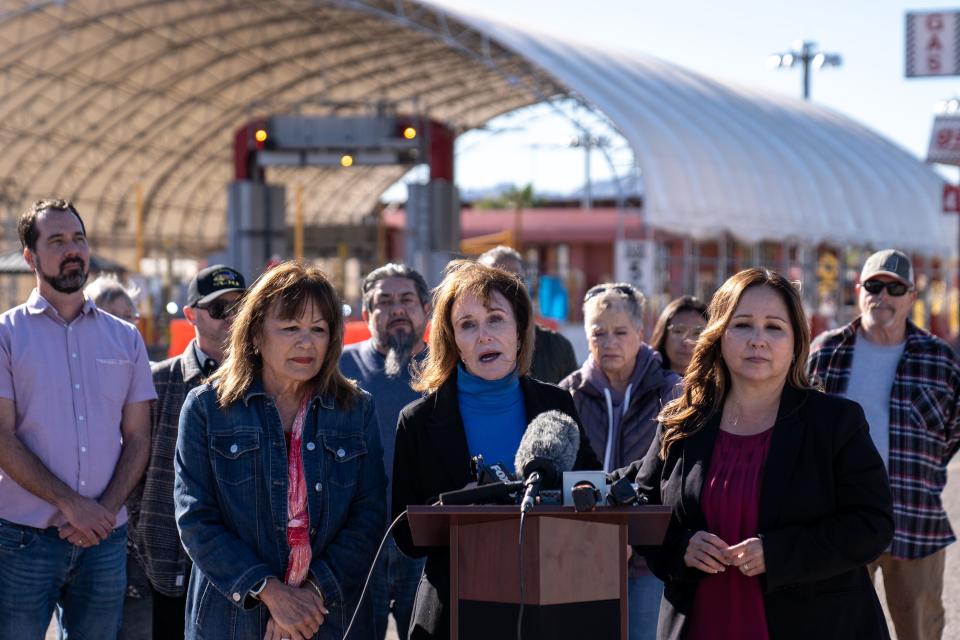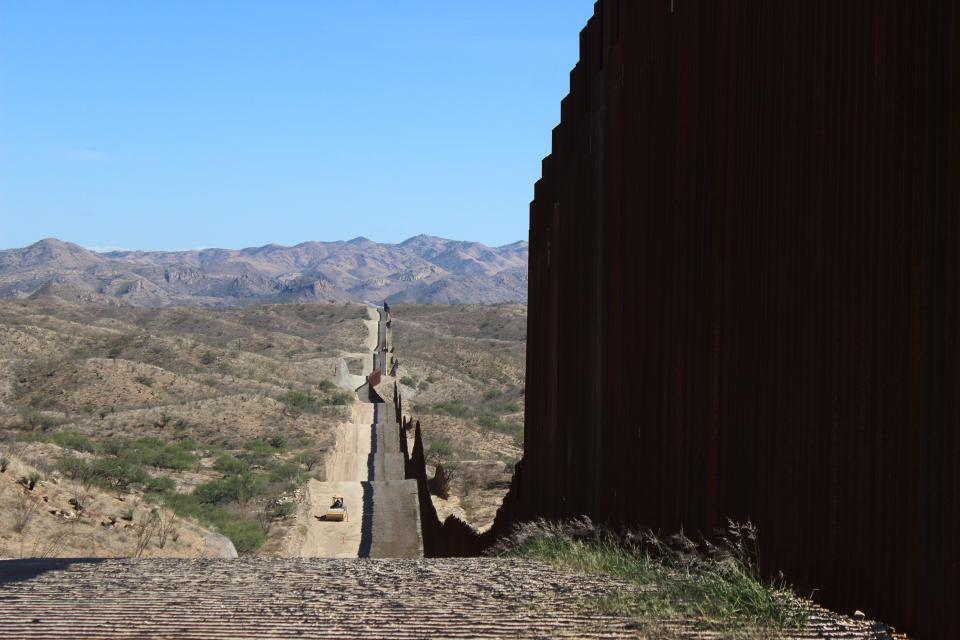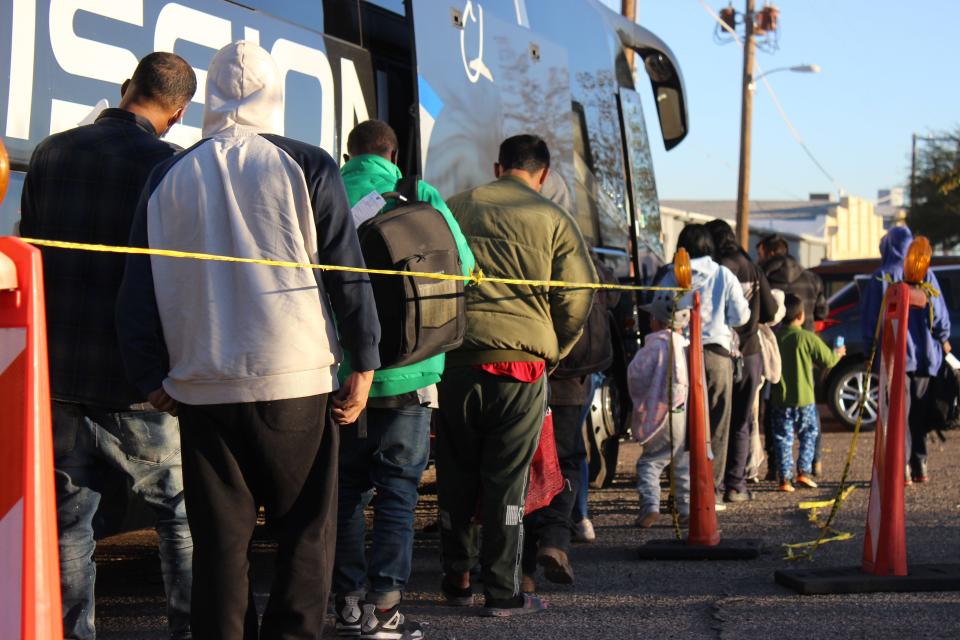Southern Arizona will run out of federal funding to help migrants on March 31
Corrections & Clarifications: Arizona's Department of Emergency and Military Affairs was misidentified in an earlier version of this article.
TUCSON — Elected and community leaders in southern Arizona are sounding off the alarm about the potential for thousands of migrants and asylum seekers processed at the U.S.-Mexico border to be released en masse in the streets of Arizona's border communities in April.
That move, they say, would undo years of collaboration and instead generate chaos at the border.
They don't have to look very far to see what the region's future may look like. Last month, San Diego County closed its migrant shelter after it ran out of funds. The U.S. Border Patrol began releasing thousands of migrants at bus stations, leaving local nonprofits to scramble to respond.
Local governments and nonprofits in southern Arizona have worked together since 2019 to build a system in coordination with U.S. border officials in Arizona to drop off migrants at designated sites such as the Regional Center for Border Health in Yuma or Tucson's Casa Alitas, the largest migrant shelter in the state, operated by Catholic Community Services of Southern Arizona.
But on March 31, they will run out of the federal funding that pays for the system that keeps migrants and asylum seekers off the streets of Arizona border communities once they've been processed and cleared for release by U.S. Customs and Border Protection.
"I think that's going to lead to a lot of chaos, and a lot more cost across the board for folks to get services, as many of the people coming through leave fairly quickly here," said Diego Piña, Casa Alitas executive director.
A spokesperson for Customs and Border Protection in Arizona said they are still working to determine how to handle community releases at the border past March 31.
The agency, which processes migrants who have appointments at ports of entry, as well as those crossing irregularly in between border crossings, has been releasing on average about 1,000 migrants each day in southern Arizona under humanitarian parole. Many of the migrants are turning themselves into border agents and seeking asylum.
Since 2019, the federal government has issued local governments and nonprofits funding through the Federal Emergency Management Agency to cover the expenses of providing humanitarian assistance to released migrants. That includes medical screenings, meals, clothing and bed space if they're unable to book travel for the same day they're released. Nonprofits and local governments also pay for transportation to the airport or bus stations, but only for migrants whose relatives or sponsors in the country already bought their tickets.
In southern Arizona, Pima County has acted as the primary fiscal agent. The county gets the government funds and distributes them to other nonprofits and local governments in the region. The county has received $70 million from FEMA over the past five years.
The latest round of funding, allocated by Congress to the newly created Shelter and Services Program, will run out March 31.
Local governments, such as Pima County, have said they will not dip into their general funds and will have to end their participation in the system developed in southern Arizona to prevent migrants from being released onto the streets.
"Everybody was out looking very hard to see how we can squeeze the nickels and roll the programs as far as they could be rolled," said Jan Lesher, the Pima County administrator. "We wanted to make sure that we have ended the program while there are still dollars available to make sure that there is no residual impact on the Pima County taxpayer."

The costs to provide humanitarian assistance to migrants have increased as more migrants cross the border through southern Arizona. The Border Patrol's Tucson Sector, which covers Pima, Santa Cruz and Cochise County, is the busiest crossing route for migrants along the southern U.S. border.
Pima County said the costs to provide humanitarian assistance to migrants in the region top $1 million per week. Tucson Mayor Regina Romero and other local leaders say Congress should be on the hook financially for covering those expenses because border and immigration enforcement is the federal government's responsibility.

"Congress needs to do their jobs, they have the power of policymaking and they have the power of assigning funds to policies. Let them do that," Romero said. "They have an opportunity to act and they have refused to act. And it should not fall on the shoulders of the city of Tucson or Pima County to pick up on their lack of action."
Congress passed a spending bill over the weekend to avoid a government shutdown and allocated $650 million to replenish the Shelter and Services Program.
On Friday, Reps. Ruben Gallego, Raúl Grijalva and Greg Stanton, all Arizona Democrats, sent two letters to Homeland Security Secretary Alejandro Mayorkas urging him to get the funding quickly to nonprofits and local government at the border.

Grijalva and Stanton urged FEMA to allocate a greater share of resources to border communities, noting that New York received nine times the amount allocated to Arizona in the last round of funding.
"Despite this disproportionate allocation, Arizona has experienced dramatic surges of migrant crossings," their letter said.
Gallego insisted that if FEMA is unable to award funds to local governments and nonprofits before funding runs out on March 31, the department should "allow for full retroactive reimbursement of expenses incurred between a fiscal cliff."
While there is some uncertainty about what will happen when the federal funding runs out, some effects are taking shape.
Casa Alitas has told half its staff it won't be able to pay them past March 31. They also plan on closing the largest of the two county-owned buildings they use to assist released migrants and asylum seekers. The remaining facility, a converted juvenile detention facility, will have the space for about 150 migrants, vastly reducing their capacity to take in migrants from across southern Arizona.
That likely means they will have to prioritize and make space only for families with children and other vulnerable migrants, Piña said.
"We've avoided the street releases for so long because we've all worked together and we've developed a really nuanced system, and I think we just need to keep working towards that," Piña said. "And if we're going to have this problem where the funding is going to be held up for a little while, then we need to figure out as a team how we're going to work through as Tucson, and to build out our resources to look different, but not to be different."
Starting April 1, without the additional shelter space in Pima County, as many as 400 migrants could be released each day into the streets in Tucson, which houses the regional headquarters for Customs and Border Protection.

Nogales, a city of 20,000 people about 60 miles south of Tucson that houses a large Border Patrol station and the main border crossing where they process asylum seekers, could see 400 migrants released each day.
Douglas, a city of 16,000 about 90 miles southeast of Tucson near another patrol station, could see between 100 to 150 migrants released per day.
Customs and Border Protection has already been releasing migrants in Nogales and Douglas. Neither city has shelters or major transportation infrastructure. When those releases began, Arizona's Department of Emergency and Military Affairs stepped in.
The state agency has averaged about 14 buses per day, transporting migrants from Nogales, Douglas and Casa Grande — another city with a large patrol station — to Tucson and Phoenix, according to Judy Kioski, the spokeswoman for DEMA. She added that DEMA will continue busing migrants from border communities as long as the state funds the program.
"DEMA will only transport legally processed asylum seekers at the request of local jurisdictions to an NGO (nonprofit) that has the capacity to support them with temporary sheltering and onward travel arrangements," Kioski said in an emailed statement.
The department said they will monitor the situation at the Arizona-Mexico border past March 31, and will continue working with local governments, nonprofits and the federal government to coordinate transportation needs. Kioski emphasized that the state has not paid for flight or bus tickets for migrants and asylum seekers.
On a recent Monday, a group of men staying at the largest of two Casa Alitas shelters in Tucson helped unload donations from an 18-wheeler and drop them off at a storage space in the back of the building.
In the next room, two women staying at the migrant shelter helped sort donated clothing in the large closet. A line of men and women with children waited outside the closet to receive donated clothing.
With funding running out at the end of the month, Piña said Casa Alitas will have to rely even more on community donations and volunteers to keep the smaller shelter open and to continue providing humanitarian assistance to migrants released in southern Arizona.
Christoper Amanat, an 18-year-old high school student, has volunteered at Casa Alitas since last summer. He was born in Tucson to Chinese and Iranian parents. Amanat is fluent in French and Mandarin, which has come in handy because there has been an increase in migrants arriving from non-Spanish-speaking countries around the globe.
"It's human connection that I really value. And it also is giving me context on my own family's immigration story and America's migration story in general," Amanat said. "I feel like that's what's been most meaningful, and that's why I wanted to be here, to just experience it all."
Have any news tips or story ideas about immigration in the Southwest? Reach the reporter at rafael.carranza@arizonarepublic.com, or follow him on X (formerly Twitter): @RafaelCarranza.
This article originally appeared on Arizona Republic: Migrants could be released in Arizona border cities starting in April

